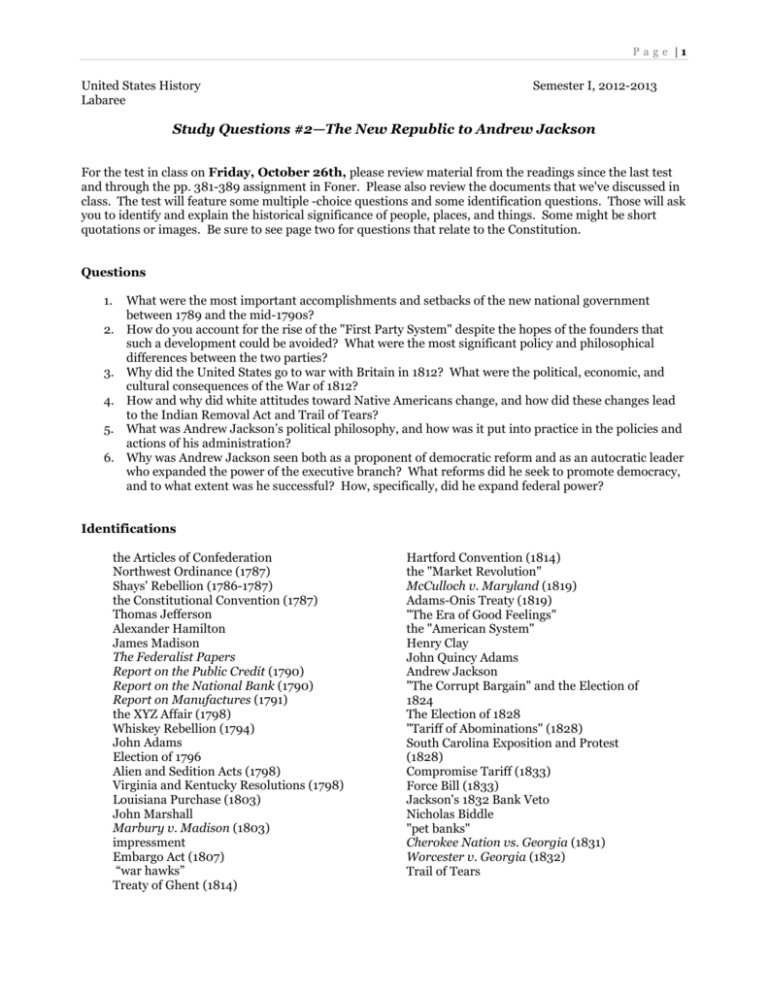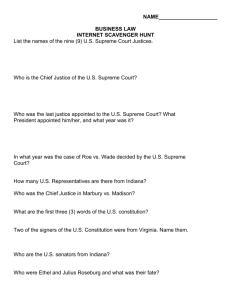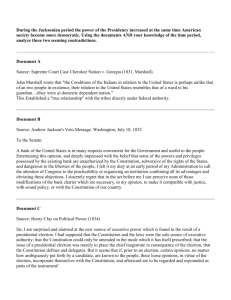United States History
advertisement

P a g e |1 United States History Labaree Semester I, 2012-2013 Study Questions #2—The New Republic to Andrew Jackson For the test in class on Friday, October 26th, please review material from the readings since the last test and through the pp. 381-389 assignment in Foner. Please also review the documents that we've discussed in class. The test will feature some multiple -choice questions and some identification questions. Those will ask you to identify and explain the historical significance of people, places, and things. Some might be short quotations or images. Be sure to see page two for questions that relate to the Constitution. Questions 1. 2. 3. 4. 5. 6. What were the most important accomplishments and setbacks of the new national government between 1789 and the mid-1790s? How do you account for the rise of the "First Party System" despite the hopes of the founders that such a development could be avoided? What were the most significant policy and philosophical differences between the two parties? Why did the United States go to war with Britain in 1812? What were the political, economic, and cultural consequences of the War of 1812? How and why did white attitudes toward Native Americans change, and how did these changes lead to the Indian Removal Act and Trail of Tears? What was Andrew Jackson’s political philosophy, and how was it put into practice in the policies and actions of his administration? Why was Andrew Jackson seen both as a proponent of democratic reform and as an autocratic leader who expanded the power of the executive branch? What reforms did he seek to promote democracy, and to what extent was he successful? How, specifically, did he expand federal power? Identifications the Articles of Confederation Northwest Ordinance (1787) Shays' Rebellion (1786-1787) the Constitutional Convention (1787) Thomas Jefferson Alexander Hamilton James Madison The Federalist Papers Report on the Public Credit (1790) Report on the National Bank (1790) Report on Manufactures (1791) the XYZ Affair (1798) Whiskey Rebellion (1794) John Adams Election of 1796 Alien and Sedition Acts (1798) Virginia and Kentucky Resolutions (1798) Louisiana Purchase (1803) John Marshall Marbury v. Madison (1803) impressment Embargo Act (1807) “war hawks” Treaty of Ghent (1814) Hartford Convention (1814) the "Market Revolution" McCulloch v. Maryland (1819) Adams-Onis Treaty (1819) "The Era of Good Feelings" the "American System" Henry Clay John Quincy Adams Andrew Jackson "The Corrupt Bargain" and the Election of 1824 The Election of 1828 "Tariff of Abominations" (1828) South Carolina Exposition and Protest (1828) Compromise Tariff (1833) Force Bill (1833) Jackson's 1832 Bank Veto Nicholas Biddle "pet banks" Cherokee Nation vs. Georgia (1831) Worcester v. Georgia (1832) Trail of Tears P a g e |2 From the Constitution (including the Bill of Rights). Please refer to the language of the original Constitution as some of the provisions have been changed by subsequent amendments. ARTICLE I The House and Senate 1. How often are members of the House of Representatives chosen? 2. Who may vote for members of the House? 3. What are the qualifications for membership in the House? 4. How are senators chosen? 5. What are the qualifications for membership in the Senate? 6. Who serves as president of the Senate? Congress as a Whole 7. Where must all money bills originate? 9. Review the enumerated powers of the Congress (section 8). 8. Explain the veto power of the president. ARTICLE II 1. What are the qualifications one must meet in order to be eligible to be president? 2. Under what circumstances may the president be impeached? 3. Review the electoral college process. 4. What are the enumerated powers of the president? (section 2) ARTICLE III 1. What is the provision for the tenure of office of justices on the Supreme Court? 2. Identify two cases in which the Supreme Court has original jurisdiction (section 2) 3. Identify two cases in which the Supreme Court has appellate jurisdiction (section 2). ARTICLE V 1. What are the methods by which amendments may be proposed and ratified? ARTICLE VII 1. Review the process for ratification of the Constitution. GENERAL QUESTION 1. The word “slave” does not appear in the Constitution, yet there are three provisions in the document that refer to slaves. Review what they are. CHECKS AND BALANCES 1. How may Congress check the power of the president (4)? . . . the Supreme Court (4)? 2. How may the president check the power of the Congress (1)? . . . the Supreme Court (1)? 3. How may the Supreme Court check Congress and the President (1)? AMENDMENTS 1. Review the rights protected by the First, Fourth, Fifth, Sixth, and Tenth Amendments.









